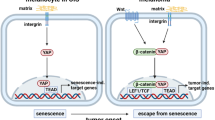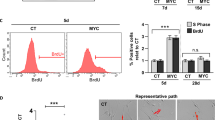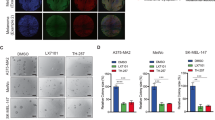Abstract
Oncoprotein C-MYC is overexpressed in human metastatic melanomas and melanoma-derived cells where it is required for the suppression of oncogene-induced senescence (OIS). The genetic events that maintain high levels of C-MYC in melanoma cells and their role in OIS are unknown. Here we report that C-MYC in cells from several randomly chosen melanoma lines was upregulated at the protein level, and largely because of the increased protein stability. Of all known regulators of C-MYC stability, levels of B56α subunit of the PP2A tumor suppressor complex were substantially suppressed in all human melanoma cells compared with normal melanocytes. Accordingly, immunohistochemical analysis revealed that the lowest and the highest amounts of PP2A-B56α were predominantly detected in metastatic melanoma tissues and in primary melanomas from patients with good clinical outcome, respectively. Importantly, PP2A-B56α overexpression suppressed C-MYC in melanoma cells and induced OIS, whereas depletion of PP2A-B56α in normal human melanocytes upregulated C-MYC protein levels and suppressed BRAFV600E- and, less efficiently, NRASQ61R-induced senescence. Our data reveal a mechanism of C-MYC overexpression in melanoma cells and identify a functional role for PP2A-B56α in OIS of melanocytic cells.
This is a preview of subscription content, access via your institution
Access options
Subscribe to this journal
Receive 50 print issues and online access
$259.00 per year
only $5.18 per issue
Buy this article
- Purchase on Springer Link
- Instant access to full article PDF
Prices may be subject to local taxes which are calculated during checkout




Similar content being viewed by others
References
Arnold HK, Sears RC . (2006). Protein phosphatase 2A regulatory subunit B56α associates with c-myc and negatively regulates c-myc accumulation. Mol cell Biol 26: 2832–2844.
Arnold HK, Zhang X, Daniel CJ, Tibbitts D, Escamilla-Powers J, Farrell A et al. (2009). The axin1 scaffold protein promotes formation of a degradation complex for c-Myc. EMBO J 28: 500–512.
Arroyo JD, Hahn WC . (2005). Involvement of PP2A in viral and cellular transformation. Oncogene 24: 7746–7755.
Bahram F, von der Lehr N, Cetinkaya C, Larsson LG . (2000). c-Myc hot spot mutations in lymphomas result in inefficient ubiquitination and decreased proteasome-mediated turnover. Blood 95: 2104–2110.
Bansal R, Nikiforov MA . (2010). Pathways of oncogene-induced senescence in human melanocytic cells. Cell Cycle 9: 2782–2788.
Bringold F, Serrano M . (2000). Tumor suppressors and oncogenes in cellular senescence. Exp Gerontol 35: 317–329.
Choi SH, Wright JB, Gerber SA, Cole MD . (2010). Myc protein is stabilized by suppression of a novel E3 ligase complex in cancer cells. Genes Dev 24: 1236–1241.
Curtin JA, Fridlyand J, Kageshita T, Patel HN, Busam KJ, Kutzner H et al. (2005). Distinct sets of genetic alterations in melanoma. N Engl J Med 353: 2135–2147.
Dang CV, Le A, Gao P . (2009). MYC-induced cancer cell energy metabolism and therapeutic opportunities. Clin Cancer Res 15: 6479–6483.
De Benedetti A, Graff JR . (2004). eIF-4E expression and its role in malignancies and metastases. Oncogene 23: 3189–3199.
Denoyelle C, Abou-Rjaily G, Bezrookove V, Verhaegen M, Johnson TM, Fullen DR et al. (2006). Anti-oncogenic role of the endoplasmic reticulum differentially activated by mutations in the MAPK pathway. Nat Cell Biol 8: 1053–1063.
Eilers M . (1999). Control of Cell proliferation by Myc family genes. Mol Cells 9: 1–6.
Grandori C, Wu KJ, Fernandez P, Ngouenet C, Grim J, Clurman BE et al. (2003). Werner syndrome protein limits MYC-induced cellular senescence. Genes Dev 17: 1569–1574.
Gray-Schopfer V, Wellbrock C, Marais R . (2007). Melanoma biology and new targeted therapy. Nature 445: 851–857.
Gregory MA, Hann SR . (2000). c-Myc proteolysis by the ubiquitin-proteasome pathway: stabilization of c-Myc in Burkitt7apos;s lymphoma cells. Mol Cell Biol 20: 2423–2435.
Hann SR . (2006). Role of post-translational modifications in regulating c-Myc proteolysis, transcriptional activity and biological function. Semin Cancer Biol 216: 288–302.
Haferkamp S, Tran SL, Becker TM, Scurr LL, Kefford RF, Rizos H . (2009). The relative contributions of the p53 and pRb pathways in oncogene-induced melanocyte senescence. Aging 1: 542–556.
Hart MJ, de los Santos R, Albert IN, Rubinfeld B, Polakis P . (1998). Downregulation of beta-catenin by human axin and its association with the APC tumor suppressor, beta-catenin and GSK3 beta. Curr biol 8: 573–581.
He TC, Sparks AB, Rago C, Hermeking H, Zawel L, da Costa LT et al. (1998). Identification of c-myc as a target of the APC pathway. Science 281: 1509–1512.
Henriksson M, Lüscher B . (1996). Proteins of the myc network: essential regulators of cell growth and differentiation. Adv Cancer Res 68: 109–182.
Hydbring P, Bahram F, Su Y, Tronnersj S, Högstrand K, von der Lehr N et al. (2010). Phosphorylation by Cdk2 is required for Myc to repress Ras-induced senescence in cotransformation. Proc Natl Acad Sci USA 107: 58–63.
Junttila MR, Puustinen P, Niemel M, Ahola R, Arnold H, Böttzauw T et al. (2007). CIP2A inhibits PP2A in human malignancies. Cell 130: 51–62.
Khanna A, Böckelman C, Hemmes A, Junttila MR, Wiksten JP, Lundin M et al. (2009). MYC-dependent regulation and prognostic role of CIP2A in gastric cancer. J Natl Cancer Inst 101: 793–805.
Kim SY, Herbst A, Tworkowski KA, Salghetti SE, Tansey WP . (2003). Skp2 regulates Myc protein stability and activity. Mol Cell 11: 1177–1188.
Larue L, Delmas V . (2006). The WNT/beta-catenin pathway in melanoma. Front Biosci 11: 733–742.
Lutterbach B, Hann SR . (1994). Hierarchical phosphorylation at N-terminal transformation-sensitive sites in c-Myc protein is regulated by mitogens and in mitosis. Mol Cel Biol 14: 5510–5522.
Maldonado JL, Fridlyand J, Patel H, Jain AN, Busam K, Kageshita T et al. (2003). Determinants of BRAF mutations in primary melanomas. J Natl Cancer Inst 95: 1878–1890.
Mannava S, Grachtchouk V, Wheeler LJ, Im M, Zhuang D, Slavina EG et al. (2008). Direct role of nucleotide metabolism in C-MYC-dependent proliferation of melanoma cells. Cell Cycle 7: 2392–2400.
Meyer N, Kim SS, Penn LZ . (2006). The Oscar-worthy role of Myc in apoptosis. Semin Cancer Biol 16: 275–287.
Michaloglou C, Vredeveld LC, Soengas MS, Denoyelle C, Kuilman T, van der Horst CM et al. (2005). BRAFE600-associated senescence-like cell cycle arrest of human naevi. Nature 436: 720–724.
Mooi WJ, Peeper DS . (2006). Oncogene-induced cell senescence-halting on the road to cancer. N Engl J Med 355: 1037–1046.
Nesbit CE, Tersak JM, Prochownik EV . (1999). MYC oncogenes and human neoplastic disease. Oncogene 18: 3004–3016.
Newson R . (2006). Confidence intervals for rank statistics: Somers’ D and extensions. The Stata J 2: 45–64.
Nikiforov MA, Popov N, Kotenko I, Henriksson M, Cole MD . (2003). The Mad and Myc basic domains are functionally equivalent. J Biol Chem 278: 11094–11099.
Nilsson JA, Cleveland JL . (2003). Myc pathways provoking cell suicide and cancer. Oncogene 22: 9007–9021.
Pollock PM, Harper UL, Hansen KS, Yudt LM, Stark M, Robbins CM et al. (2003). High frequency of BRAF mutations in nevi. Nat Genet 33: 19–20.
Popov N, Wanzel M, Madiredjo M, Zhang D, Beijersbergen R, Bernards R et al. (2007). The ubiquitin-specific protease USP28 is required for MYC stability. Nat Cell Bbiol 9: 765–774.
Rajagopalan H, Jallepalli PV, Rago C, Velculescu VE, Kinzler KW, Vogelstein B et al. (2004). Inactivation of hCDC4 can cause chromosomal instability. Nature 428: 77–81.
Sablina AA, Hector M, Colpaert N, Hahn WC . (2010). Identification of PP2A Complexes and Pathways Involved in Cell Transformation. Cancer Res 70: 10474–10484.
Sears R, Leone G, DeGregori J, Nevins JR . (1999). Ras enhances Myc protein stability. Mol Cell 3: 169–179.
Shi Y, Frost PJ, Hoang BQ, Benavides A, Sharma S, Gera JF et al. (2008). IL-6-induced stimulation of c-myc translation in multiple myeloma cells is mediated by myc internal ribosome entry site function and the RNA-binding protein, hnRNP A1. Cancer Res 68: 10215–10222.
Smalley KS, Brafford PA, Herlyn M . (2005). Selective evolutionary pressure from the tissue microenvironment drives tumor progression. Semin Cancer Biol 15: 451–459.
Vaarala MH, Väisänen MR, Ristimäki A . (2010). CIP2A expression is increased in prostate cancer. J Exp Clin Cancer Res 29: 136–140.
Wang H, Mannava S, Grachtchouk V, Zhuang D, Soengas MS, Gudkov AV et al. (2008). c-Myc depletion inhibits proliferation of human tumor cells at various stages of the cell cycle. Oncogene 27: 1905–1915.
Welcker M, Orian A, Jin J, Grim JE, Harper JW, Eisenman RN et al. (2004). The Fbw7 tumor suppressor regulates glycogen synthase kinase 3 phosphorylation-dependent c-Myc protein degradation. Proc Natl Acad Sci USA 101: 9085–9090.
Wu CH, van Riggelen J, Yetil A, Fan AC, Bachireddy P, Felsher DW . (2007). Cellular senescence is an important mechanism of tumor regression upon c-Myc inactivation. Proc Natl Acad Sci USA 104: 13028–13033.
Zhuang D, Mannava S, Grachtchouk V, Tang WH, Patil S, Wawrzyniak JA et al. (2008). C-MYC overexpression is required for continuous suppression of oncogene-induced senescence in melanoma cells. Oncogene 27: 6623–6634.
Acknowledgements
We are grateful to Dr Catherine Burkhart (Cleveland Biolabs) and Dr Shoshanna Zucker (Roswell Park Cancer Institute) for critical reading of the manuscript, Ms Carina Fung (University of Sydney) for the experimental help. This work was supported by the NIH R01 CA120244 and ACS RSG-10-121-01 grants to MAN. The work of JCM was supported in part by the NIH 5P30CA016056-34 grant.
Author information
Authors and Affiliations
Corresponding author
Ethics declarations
Competing interests
The authors declare no conflict of interest.
Rights and permissions
About this article
Cite this article
Mannava, S., Omilian, A., Wawrzyniak, J. et al. PP2A-B56α controls oncogene-induced senescence in normal and tumor human melanocytic cells. Oncogene 31, 1484–1492 (2012). https://doi.org/10.1038/onc.2011.339
Received:
Revised:
Accepted:
Published:
Issue Date:
DOI: https://doi.org/10.1038/onc.2011.339
Keywords
This article is cited by
-
Molecular dissection on inhibition of Ras-induced cellular senescence by small t antigen of SV40
Cellular and Molecular Life Sciences (2022)
-
IER2-induced senescence drives melanoma invasion through osteopontin
Oncogene (2021)
-
Pathways from senescence to melanoma: focus on MITF sumoylation
Oncogene (2017)
-
Deregulation of the protein phosphatase 2A, PP2A in cancer: complexity and therapeutic options
Tumor Biology (2016)
-
Pharmacological targeting of guanosine monophosphate synthase suppresses melanoma cell invasion and tumorigenicity
Cell Death & Differentiation (2015)



